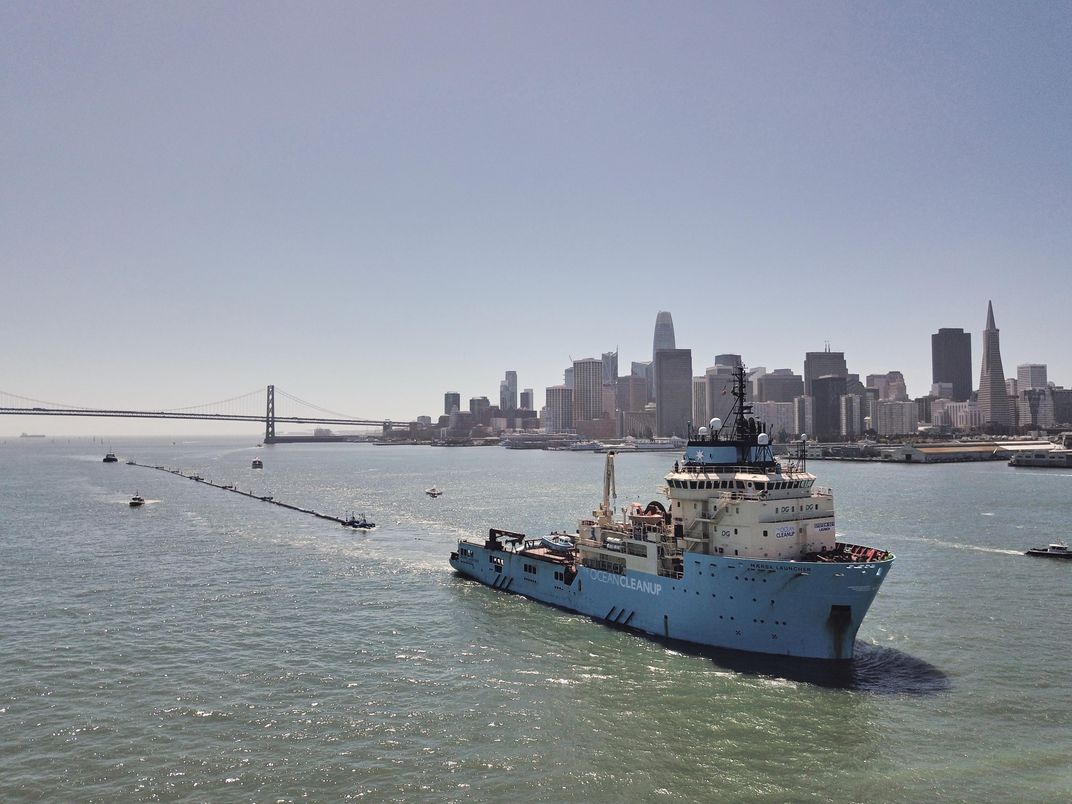2,000-Foot-Long Plastic Catcher Released to Aid Cleanup of Great Pacific Garbage Patch
Skeptics argue the device will endanger marine wildlife, exacerbate existing pollution problems
/https://tf-cmsv2-smithsonianmag-media.s3.amazonaws.com/filer/37/87/37873b66-ae66-48f5-b80e-eb90527dff90/180827_stabilizers_assembly_and_fully_launched_system-1.jpg)
Halfway between Hawaii and California, an enormous mound of garbage measuring twice the size of Texas floats in the Pacific, menacing the marine ecosystem and steadily accumulating man-made debris. This isle of plastic, better known as the Great Pacific Garbage Patch (GPGB), is made up of roughly 1.8 trillion pieces of detritus, and it shows no signs of breaking down anytime soon.
But the Ocean Cleanup project—an ambitious $20 million campaign spearheaded by Dutch inventor Boyan Slat—aims to stop the patch in its tracks by ensnaring offending debris in a 2,000-foot-long free-floating boom, or barrier. Slat and his team launched a test drive of their device on Saturday, Christina Caron reports for The New York Times, and if all goes well, they will move on to the GPGB by mid-October.
According to Science News' Carolyn Gramling, Ocean Cleanup’s “System 001” consists of a U-shaped line-up of unmoored booms fitted with a 10-foot underwater skirt, or sieve-like netting material. In theory, the device should act as an artificial shoreline, gathering plastic particles as it drifts with the Pacific’s currents. Once significant amounts of trash amass in the system, support ships will transport the junk to recycling complexes onshore.
USA Today’s Elizabeth Weise notes that System 001 is the pilot vessel of a planned fleet of 60. The device is rigged with solar-powered lights and an anti-collision system to prevent crashes with passing ships and features a tracking mechanism made up of cameras, sensors and satellites. If the test run proves successful, Ocean Cleanup hopes to launch its full fleet and, Gramling reports, remove 50 percent of the GPGB’s plastic trash over the next five years and 90 percent by 2040.
BBC News’ David Shukman writes that Slat, the 24-year-old mastermind behind Ocean Cleanup, has been an ocean conservation advocate since he went swimming in a Greek sea seven years ago and saw that the waters contained more plastic than fish. At the time, Slat was just a teenager with a seemingly outlandish, albeit imaginative, idea to save the oceans, but he eventually found investors, including the Dutch government, and engineers willing to bring his vision to life.

Lonneke Holierhoek, Ocean Cleanup’s chief operating officer, tells Shukman the team feels as if they’re in a “great hurry.” As she explains, “If we don’t [take action], all this plastic will start breaking down into smaller and smaller pieces—and the smaller the pieces are, the more harmful and … harder to extract from the marine environment [they become]."
Still, Slat’s project has attracted a slew of criticism from scientists who argue that the device will endanger marine wildlife and ultimately exacerbate existing problems.
In a blog post written for Southern Fried Science, David Shiffman outlines key concerns regarding Ocean Cleanup, citing a lack of understanding of the issues at hand (for example, much of the plastic littering the oceans is “small and well-dispersed," meaning the device will be unable to collect it), inadequate structural integrity that may result in the system breaking down and creating additional ocean garbage, and an inability to distinguish between plastic and living things.
Shiffman surveyed 15 ocean pollution experts and found that more than a quarter believed the project was “a bad idea with little or no redeeming value.” None of the experts thought Ocean Cleanup would be able to remove plastic without killing marine wildlife, and a slight majority argued that preventing additional plastic from entering the ocean would be a more effective goal than trying to remove existing plastic.
BBC News’ Shukman notes that all objects drifting in the ocean end up covered in algae, which attracts plankton and, in turn, larger fish. George Leonard, chief scientist at the Ocean Conservancy, further explains to The New York Times’ Caron that “any sort of structure in the open ocean … acts as a fish-aggregating device,” essentially luring unsuspecting marine animals to their deaths.
In her interview with Shukman, Ocean Cleanup’s Holierhoek counters these skeptics by citing an independent environmental study that found the impact of such “fish aggregation devices” can be minimized by generating noise to scare fish away.
Holierhoek also tells Southern Fried Science’s Shiffman that a nearby vessel will monitor the device’s interactions with marine life. In addition to being brightly colored in order to allow animals to see it, System 001 features a “flow system” that should gently move animals out of the plastic collector’s path.
Despite the skepticism directed toward his invention, Slat remains optimistic. Although he “fully” agrees that Ocean Cleanup is not the definitive solution to plastic pollution, he points out that the plastic currently littering Earth’s waters won’t disappear on its own.
As Slat concludes, “We have to clean it up at some point in time and, actually, I would say the sooner the better."
/https://tf-cmsv2-smithsonianmag-media.s3.amazonaws.com/accounts/headshot/mellon.png)
/https://tf-cmsv2-smithsonianmag-media.s3.amazonaws.com/accounts/headshot/mellon.png)